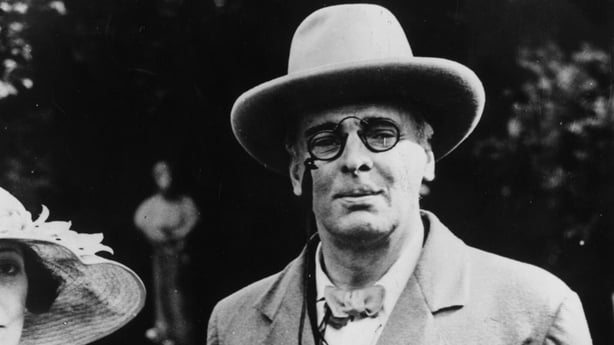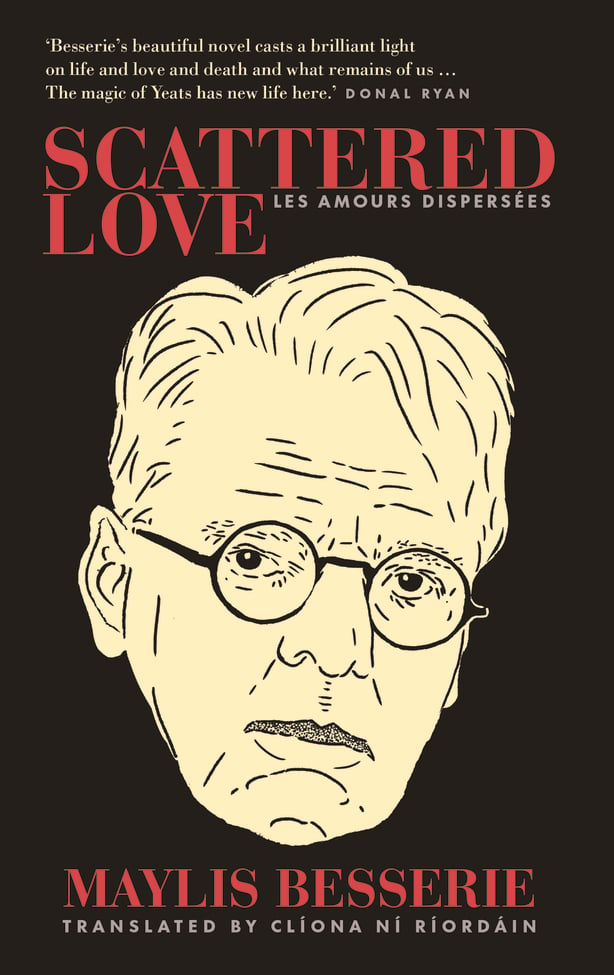We present an extract from Scattered Love, the new book by Maylis Besserie, translated by Clíona Ní Ríordáin.
She is Maud Gonne, the muse of writer William Butler Yeats. Yeats here returns as a ghost, having been buried in southern France in January 1939 at Roquebrune-Cap-Martin. Ten years later his remains are repatriated to Ireland. He emerges from his grave to recount his thwarted love for Maud, a story blending with the movement for Irish independence in which they each played an integral part.
Yeats' ghost has suddenly appeared as diplomatic documents have come to light, casting doubt on the contents of the coffin brought back to Sligo for a state funeral. Where did the poet’s body go? Does he still hover 'somewhere among the clouds above’? What remains of our loves and our deaths, if not their poetry?
The wind rustles in the old graveyard, moving the folding table on which Madeleine lays the copy of the letter written in blue ink that she is about to read to the others: the first of the letters to be published by The Irish Times and all the Irish newspapers anxious to expose the scandalous treatment of Yeats's body. The ambassador’s handwriting is as sloppy as that of a quack writing a hurried prescription to get rid of a patient – there are dots missing on the 'i’s, trailing crosses on the ‘t’s. Madeleine warns the six members of the association seated in front of her of the difficulty in deciphering certain passages: the faded ink, the illegibility of certain names. Despite this, she starts to read and becomes the voice of the author – Stanislas Ostrorog, French ambassador to Dublin in 1948. He draws the ministry’s attention to the thorny question of the transfer of Yeats’s remains, a matter which, if not addressed, could cause serious problems. He writes a paragraph on the glory of the greatest contemporary poet in the English language, outlining the repercussions for France on the diplomatic front, the risks involved. Yeats was a national treasure, the Victor Hugo of Ireland, a Nobel Prizewinner and a senator. So the ambassador fears the mishaps, the fallout if the press ever gets wind of the mess, if people learn of the lies told about his remains.
We need your consent to load this rte-player contentWe use rte-player to manage extra content that can set cookies on your device and collect data about your activity. Please review their details and accept them to load the content.Manage Preferences
Listen: Scattered Love: Maylis Besserie talks to RTÉ Arena
Before the transfer, he was contacted by Yeats's son Michael, who had just learned that his father was not in his tomb in Roquebrune but in the mass grave. The family knew nothing of the decision. 'Unbelievable!’ Madeleine stresses that the action had been taken without their consent. The more of the letter she reads, the more unclear it becomes, floundering in a puddle of arguments that blur the lines and make the reader lose sight of what really happened. Anxious to protect his own interests, the diplomat does not explain Yeats’s presence in the mass grave; he blames the family, accusing them of negligence, of not having provided a burial place for their august relative. Paris was worried that the French authorities would be held responsible for the incident, and he hoped to keep it out of the press until the transfer to Ireland and the state funeral had righted the wrong. To cover up the affair, he took all necessary precautions, sent one of his men to Roquebrune to find the body, to put it in a coffin without anyone knowing about it.
Madeleine wonders how Paris’s man could have found Yeats in a centuries-old grave among dozens of corpses. She suspects that the ambassador wanted to hide the deception and show that his administration had behaved in a manner above reproach – he had even commissioned a report from his subordinate to that effect. Madeleine and the others speculate about the background to the affair, about the negotiations conducted on the spot between the Quai d’Orsay’s man and the Roquebrune authorities, the officials and the undertakers. None of this appears in the letter, but they read between the lines. What is unwritten does not need to be erased. It is the deliberately blank spaces that harbour the scandal within, the pain of the families, the mystery of the fate of the forgotten dead that the Scattered are determined to resolve. Terrifying images of corpses, piled-up remains, limbs entwined in the rigidity of death, now flash around the table in the minds of the descendants who are ready to defend them.

Each one gathered here can feel the dead person they represent resurface in the old cemetery. The cobbler is reminded of the grandfather he knew only through his portrait. The black-and-white photo of him with his incredible handlebar moustache and sideburns sat on his grandmother’s bedside table; a dark shadow furrowed her wrinkled face whenever she looked at it, and an awkward silence followed. A dead silence, the cobbler used to think when his grandmother’s eyes stared piercingly at the picture as if she were seeing through it, before losing herself in the void, as if she had fallen into a well of sorrow. Not a dead man, though, but a ghost who always followed her and made the old woman blush with shame; it had persecuted her to the end. She understood that the ghost was taking a form of justifiable revenge and believed she deserved the painful visions that made her feel guilty. She had failed to save him, failed to free him from the hell into which he had sunk, failed to erase the debts and bitterness that had made him go under. She hadn’t even managed to take his body down, hadn’t managed to unhook her poor husband whose body was still twitching when she came across it, performing his last dance without her. She had endlessly replayed the scene until she joined him, three decades later. The cobbler could still hear her telling him about the men who had run like the blazes to get there – neighbours who had come to help the doctor, the smell of death in the room. The doctor had dictated the procedure to follow: the knot had to be loosened, the pulse checked and resuscitation started. She stood there, frozen in pain in front of her man – anoxia, cerebral oedema – her eyes fixed on the eyes of one who no longer blinked, who could no longer see her, whose eyelids were being closed – he was pronounced dead at 5.12 pm. There was nothing left apart from a letter displayed in plain sight, in which he had not known what to say. A few words of apology and then silence. She too had remained silent; she should have prayed, just in case, while he could still hear her. There had been no ceremony, no mass for the hanged man; his parents had disowned their son who had died in a state of sin and had even banished him from the family vault. She had not been able to afford a funeral and had seen him off coffin-less, in a sheet, ‘thrown into the grave like a bundle of dirty laundry, like a pauper’. That evening, she had found herself lying at her child’s feet so that he would fall asleep. The ghost had come – for the first visit, and he had never left her. Where is he today, the hanged man who was his grandfather? Scattered? His head to the north, his feet to the south? Is there anything left of him nearby, in the cemetery? Has the soil of Roquebrune cemetery finally reconciled them in a nil–all draw? The cobbler would like to know.
As he tries to make sense of it, Madeleine returns to the issue of the identification of the mortal remains sent back to Ireland. How could they have reconstructed Yeats’s body with any certainty? Did they take bones at random, any bones that came to hand? A skull here, a tibia there? Did the pieces of the dead cohabiting together in the box form a single creature made up of dozens of bodies? Could the bones of the poet be entirely absent? As long as there was no DNA analysis, anything was possible. While waiting for the legal case to be set in motion, Madeleine suggested that she should find out how they went about things at the time. She suggested that she should call on the expertise of a funeral director, and that she would invite him to one of their next meetings.
In the following paragraph, the ambassador shamelessly writes that the Irish minister knows nothing about it, and even boasts of the favourable diplomatic benefits of the operation. He was thanked warmly by the Irish Minister of External Affairs. That takes the biscuit.
The Scattered listen to Madeleine, stifling their reactions in an offended silence, a silence that only the wind interrupts. The gruff southern wind growls in the old village cemetery and makes the dark branches of the umbrella pines dance. Madeleine distributes the investigative report quoted in the letter. It is signed by Paris’s envoy. A certain ‘Cailloux’, meaning pebbles. You couldn’t make it up.

Scattered Love is published by Lilliput Press - find out more here.

